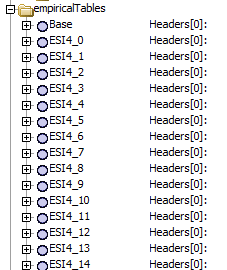I have developed a simple ER sim and would like to establish the arrival of patients based on data from our EMR.
The table below represents 1 months worth of arrivals by ESI level by time of day. ( am just focusing on 5 and 4 right now.
I want to use this data to establish the quantity of patients that arrive per hour by ESI level however I am struggling to apply it to one day at a time. for example it keeps trying to have 26 patients arrive at 1am with ESI of 4 instead of just 1 or 2.
I am very new to flex sim so let me know if other screen shots would be helpful.
Thanks, Aaron
| Time | ESI 5 | ESI 4 | ESI 3 | ESI 2 | ESI 1 |
| 0:00:00 | 0 | 31 | 39 | 17 | 6 |
| 1:00:00 | 5 | 26 | 35 | 23 | 4 |
| 2:00:00 | 3 | 14 | 36 | 19 | 5 |
| 3:00:00 | 3 | 15 | 25 | 15 | 2 |
| 4:00:00 | 3 | 11 | 27 | 11 | 2 |
| 5:00:00 | 4 | 16 | 27 | 13 | 3 |
| 6:00:00 | 1 | 16 | 28 | 11 | 4 |
| 7:00:00 | 3 | 44 | 41 | 28 | 6 |
| 8:00:00 | 6 | 81 | 75 | 30 | 6 |
| 9:00:00 | 1 | 80 | 86 | 44 | 9 |
| 10:00:00 | 8 | 89 | 83 | 73 | 12 |
| 11:00:00 | 3 | 72 | 97 | 50 | 7 |
| 12:00:00 | 7 | 81 | 94 | 60 | 9 |
| 13:00:00 | 5 | 93 | 104 | 47 | 5 |
| 14:00:00 | 7 | 68 | 92 | 45 | 4 |
| 15:00:00 | 3 | 62 | 98 | 40 | 5 |
| 16:00:00 | 8 | 86 | 78 | 57 | 5 |
| 17:00:00 | 4 | 104 | 88 | 44 | 3 |
| 18:00:00 | 2 | 97 | 75 | 43 | 4 |
| 19:00:00 | 6 | 64 | 84 | 50 | 8 |
| 20:00:00 | 5 | 61 | 74 | 28 | 7 |
| 21:00:00 | 10 | 48 | 74 | 19 | 6 |
| 22:00:00 | 5 | 45 | 47 | 28 | 4 |
| 23:00:00 | 0 | 0 | 0 | 0 | 0 |


 The values in the first column are the percentage chances of the rows to get chosen. They all have the same 100/30 chance in this case.
The values in the first column are the percentage chances of the rows to get chosen. They all have the same 100/30 chance in this case.
